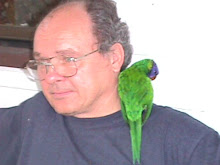
Yellow-faced Honeyeater @ nest
It couldn’t happen again, could it? But it did. I’d come across a similar problem when reflecting on the Noisy Friarbird Philemon corniculatus [previous post].
Heavy overnight rain [in excess of 50mm over a few hours] found us, the following morning, walking down to the front gate, inspecting the condition of the track; we were expecting guests for dinner later that evening and didn’t want them becoming bogged if the surface had become too soft. It was as we passed the run-off to the “Duckpond” [a small dam we had excavated a little over a year ago] that we first heard the call of the Yellow-faced Honeyeater Lichenostomus chrysops. A moment later it flew across the track, disappearing somewhere in the woodland to the east.
It wasn’t new to the Year List [we’d ticked the first back in January]. It wasn’t even new for the 2011 Allen Road List [that had also occurred in January]. It had however become something of a rarity to our backyard.
Our ornithological position has always been to the effect that in the early years of our residence in Allen Road, the Yellow-faced had been the dominant honeyeater; its close relative, the Blue-faced Honeyeater Entomyzon cyanotis a comparative newcomer, a latter-day usurper. It was a stance we adhered to rather rigidly.
Blue-faced Honeyeater, juvenile [note the green rather than blue face].

Then of course, as in the case of the Noisy Friarbird, along came Bluebird Technology’s Bird Journal software. I can only repeat that neither Fay nor I have any commercial association with this company but nevertheless, while admitting that it does not perfectly dovetail with all or birding requirements, it is one of the best bird recording programs I have come across in many a year.
In transcribing hundreds of handwritten records onto the computer it inevitably brought a few facts to light; shed a little reality over the dimness cast by time.
Yes, the Yellow-faced Honeyeater has seniority over the Blue-faced; it was first recorded here [as the 13th new Backyard List species] on only our second visit to Allen Road, 21 April 2001. It was there again on the subsequent visit, Saturday 12 May 2001 and again on the next day, Sunday 13 May.
However, also present that Sunday, as the 35th addition to the Backyard List, was the Blue-faced Honeyeater.
The Yellow-faced Honeyeater was reported on all 13 trips to Allen Road throughout June 2001, including one visit [29 June] when only two honeyeaters were recorded [the other being the Noisy Miner Manorina melanocephala]. The Blue-faced was not.
That initial pattern set the mould: the Yellow-faced was the dominant resident honeyeater; the Blue-faced was merely an occasional visitor.
That remained a fairly accurate assessment throughout 2002, although the Blue-faced was beginning to put in more appearances and, on albeit rare occasions, was present when the Yellow-faced was not [e.g. 31 March; 25 June 2002].
The status quo remained until the end of the first week in July 2003; the Yellow-faced was present on our visit over the first weekend in July 2003 [4-6th]. It was not reported in any of the five subsequent July visits nor, indeed, in any of the eight visits made in the following month, August.
It was next recorded on 4 October and again on 1 November 2003. During the latter part of 2003 the Blue-faced Honeyeater was beginning to be recorded on almost every trip to Allen Road.
Their roles had reversed; the Blue-faced had [and remains]] the more dominant of those two honeyeaters.
Image via en.wikipedia.org/wiki/File:Lewins_Honeyeater

I apply the pronoun those in that in all these reflections on the seniority and reporting longevity between the Yellow-faced and Blue-faced Honeyeaters [species with the word honeyeater in their name], Bird Journal rather sharply reminded me that throughout this same period two other members of the honeyeater family, apart from the Noisy Miner and the migratory Little Philemon citreogularis and Noisy Friarbirds, were consistently recorded and regarded as permanent at Allen Road; Lewin’s Honeyeater Meliphaga lewinii [first recorded on the same day as the Blue-faced, 13 May 2001] and the Striped Honeyeater Plectorhyncha lanceolata which was initially recorded on 21 April 2001 [alongside the Yellow-faced Honeyeater], giving it seniority over the Blue-faced and Lewin’s Honeyeaters. Indeed, the latter has remained a firm fixture, a resident, on our sightings lists while the former, like the Yellow-faced, now puts in only rare visits.
Striped Hineyeater. Image via Ozanimals.com

Nevertheless, hope remains for the Yellow-faced Honeyeater; over the past week it has been heard calling from somewhere in the northeast quadrant on at least three occasions.
There are 74 species listed under the Meliphagidae family [Christidis & Boles, 2008] of which 14 have been recorded at Allen Road. Along with the seven already mentioned above there have also been:
Eastern Spinebill Acanthorhynchus tenuirostris
Spiny-cheeked Honeyeater Acanthagenys rufogularis
Brown Honeyeater Lichmera instincta
Black-chinned Honeyeater Melithruptus gularis
Brown-headed Honeyeater Melithreptus brevirostris
White-throated Honeyeater Melithreptus albogulasris
White-naped Honeyeater Melithreptus lunatus

No comments:
Post a Comment